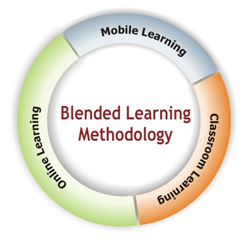By Doug Ward
Angelique Kobler offered an uncomfortable question about education last week.
Kobler, assistant superintendent for teaching and learning at the Lawrence school district, met with the KU Task Force on Course Redesign and explained the steady expansion of blended learning in Lawrence public schools.
To illustrate the need for new ways of engaging students, she said, she asks her staff a question that can make even the most experienced teacher squirm: Has teaching occurred if learning hasn’t?
Education is never that cut and dried, of course. Learning depends on a wide range of factors that have nothing to do with an individual teacher. Kobler knows that. She uses the question to spur discussion about the need for change.

Today’s students are different from those a generation ago, as are their needs in an era when laptops and smartphones offer access to nearly unlimited amounts of information.
Fifteen years ago, Luc E. Weber, a professor of public economics at the University of Geneva, made an observation that has grown only more apparent today: “Teachers will have to accept that their role is changing,” Weber wrote in Challenges Facing Higher Education at the Millennium. “They will be decreasingly information providers and increasingly animators and commentators in charge of giving context and in-depth understanding of an area.” (p. 10)
Blended classrooms force teachers to heed that call for change. Many teachers are responding. Lawrence public schools started with a pilot program of eight blended classrooms in Spring 2013. By fall of this year, the district plans to expand that number to 150.
Kobler defines blended as “somewhere between traditional and virtual.” Students in blended classes can use whatever means help them learn: Some choose textbooks. Others work through assignments online. Sometimes students work alone. Other times, they reach out to peers to help them understand a topic or a concept.
In all those scenarios, the teacher keeps tabs on students and meets with them individually or in groups to keep them on track.
This approach isn’t easy to pull off. Teachers have to be willing to experiment, to make mistakes in front of students, and to talk with students about those mistake, Kobler said. Blended classrooms can seem chaotic as students go in several different directions at once, something that doesn’t also sit well with teachers who demand order.
Parents, on the other hand, have been enthusiastic about the blended approach, sometimes asking that their children continue in a blended classroom because the approach works well for them.
On the other hand, high-achieving students sometimes struggle in a blended environment, something I’ve found in my own classes. High achievers often thrive within a tightly structured, traditional model of “tell me what I need to know and I’ll tell it back to you on a test.” A blended, flipped or hybrid environment strips away this neat order and pushes students to find their own structure and to pace their own learning. That’s a far more difficult task, but it’s also far more meaningful in the long run.
Let me put a twist on Kobler’s earlier question: Can education survive if educators don’t adapt to the needs of students?
That question may make us squirm as well, though it’s also a bit easier to answer.
“If we don’t keep up, we will become irrelevant,” Kobler said.
Doug Ward is an associate professor of journalism and a fellow at the Center for Teaching Excellence. You can follow him on Twitter @kuediting.
Tagged active learning, blended learning, course redesign, flipped courses, hybrid learning